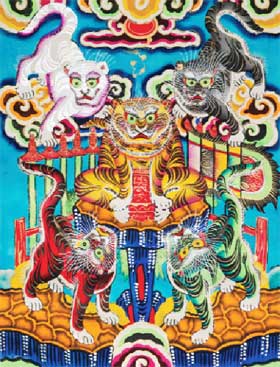The renowned collector Pham Duc Si is exhibiting his stunning collection of rare Hang Trong folk paintings in Hanoi
 A carpenter by trade, an artist at heart, Pham Duc Si surprised plenty of people last October when he suddenly revealed his vast collection of traditional ceremonial paintings at an exhibition hosted by Viet Art Centre in Hanoi. Where had this collector been hiding? An accompanying book published one month later also detailed 400 of his ceremonial paintings, an invaluable resource for budding art historians.
A carpenter by trade, an artist at heart, Pham Duc Si surprised plenty of people last October when he suddenly revealed his vast collection of traditional ceremonial paintings at an exhibition hosted by Viet Art Centre in Hanoi. Where had this collector been hiding? An accompanying book published one month later also detailed 400 of his ceremonial paintings, an invaluable resource for budding art historians.
For years Si had earned his keep by making frames and statue platforms for students studying at the Vietnam Arts University. All the while he had been collecting art and pottery and now he boasts four collections: one of Dong Son and Chinese Han-pottery; one of propaganda art from the US-Vietnam; one of ethnic ceremonial art; and lastly the Hang Trong paintings.
Unlike the much-revered Dong Ho folk paintings, the number of Hang Trong paintings in existence is limited. There are no artists left on Hang Trong street producing such paintings – though there are plenty of workshops producing counterfeit versions of Van Gogh or Gustav Klimt’s masterpieces!
The last “Hang Trong” artist is Le Dinh Nghien – also an employee at the Vietnam Arts Museum – and he resides in Ly Nam De street.
Hang Trong art has a history that dates back to the 17th century. Different to the bucolic setting of Dong Ho, the Hang Trong guild was located in the very heart of what is now known as the Old Quarter.
This was one of the few places where folk paintings were made in the country during these feudal times. According to historians, Hang Trong craftsmen began to make pictures during the eleventh and twelfth months of the Lunar calendar so that they could meet the high demand during the Lunar New Year holiday when Hang Trong paintings were seen as an indispensable decoration for each Hanoi household.
Hang Trong craftsmen also produced ceremonial pictures for Taoist temples and Buddhist pagodas in the capital, formerly known as Thang Long. Thus, Hang Trong paintings are symbolic of Vietnam’s traditional culture and representative of the people’s long-lasting aesthetic values.
The paintings started out with the sculpting of a woodblock prints. The craftsman then used the woodblock to print a black outline. He would then add details and colours by hand.
The craftsmen often used bright and attractive principal colours such as pink, blue, green, red or yellow. Every Hang Trong picture varied according to the artist’s style. Setting Hang Trong paintings apart from Dong Ho paintings is also the paper, called Xuyen chi paper.
Common themes depicted in Hang Trong paintings were spiritual and cultural. Symbols such as a white tiger or a carp were often used. The paintings were more influenced by Buddhism and Taoism than Dong Ho paintings. But folkloric content was also common. You might see a game of blind-man’s buff or spot traditional characters like the toad scholar – both popular decorative features for families celebrating Tet. Some titles in Si’s collection include Five Tigers, Carp Looking at the Moon and Virgin Girls.
Si has collected paintings in all states. Sometimes he purchased paintings that were torn to pieces or falling apart.
“For old or damaged paintings, I brought them to Le Dinh Nghien and asked him to repair them,” explains Si. “I didn’t study fine arts or develop knowledge on folk paintings from any school. I’ve learnt everything I know through my own trips and research.”
Besides the old paintings, part of his collection includes newer creations, printed and drawn by Le Dinh Nghien. Si has also worked hard to forge links with the likes of artist and ethnologist Phan Ngoc Khue, the Chinese and Ancient Vietnamese script expert Cung Khac Luoc and the artist Do Duc. In the course of amassing his collection, Si has increased his knowledge of national culture, and is now offering us a chance to share that with him.
The exhibition lasts till September 15 at Viet Art Centre, 42 Yet Kieu, Hanoi.
Beautiful Vietnam » Hanoi
A precious treasure
More Hanoi
- Hanoi promotes experiential tourism linked to heritage, trade villages(04/14/2024)
- Beauty of Hanoi’s Madagascar almond road(03/22/2024)
- Hanoi in the changing season(03/13/2024)
- Hang Dau flower garden gets facelift(03/10/2024)
- Lotus to be grown at Hanoi lakes(03/01/2024)
- Hanoi reveals new bamboo garden(02/29/2024)

Leave your comment on this story